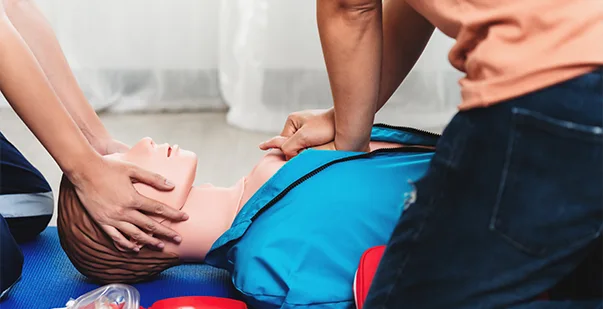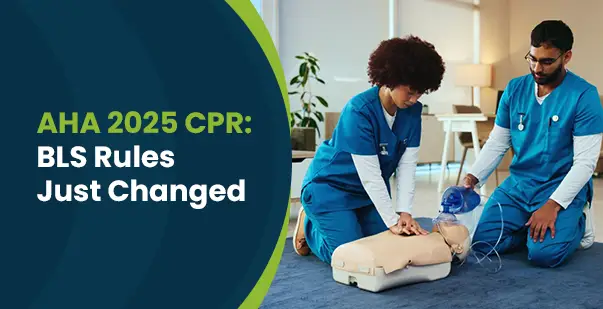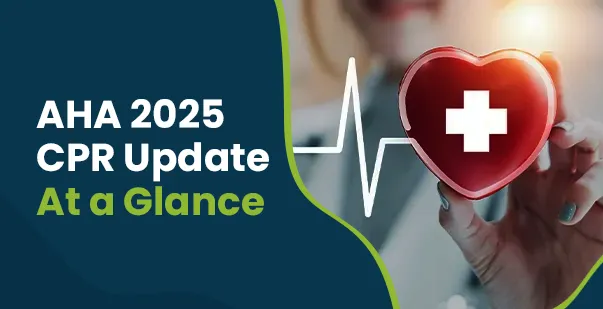Chest compression feedback devices have changed the field of cardiopulmonary resuscitation by offering effective guidance and evaluation during lifesaving procedures. Did you know that real-time feedback improves the quality of chest compressions for out-of-hospital cardiac arrests?
By monitoring and keeping track of the quality of chest compressions, it offers valuable help to rescuers and healthcare professionals. Keep reading the blog to explore the importance of chest compression feedback device monitor, functionality, benefits, and more.
What is the Importance of Chest Compression Feedback Devices?
When a person experiences a cardiac arrest, it is crucial to offer immediate CPR to maintain blood flow and oxygenation. However, the quality of the chest compressions impacts the effectiveness. This is where chest compression feedback devices come into play, offering real-time information on the efficiency and quality. Here is the importance of chest compression feedback devices.
1. Ensures Optimal Compression Depth
The device monitors whether the compressions are deep enough to circulate blood effectively. Proper compression depth is essential for maintaining blood flow to vital organs, and without feedback, it’s easy to apply too little or too much pressure.
2. Helps Maintain the Right Compression Rate
A consistent compression rate of 100-120 compressions per minute is recommended during CPR. The feedback device tracks the speed and alerts rescuers to the pace.
3. Promotes Full Chest Recoil
Allowing the chest to fully recoil between compressions is essential for proper blood flow. The device reduces the need for rescuers to lean, further maximizing blood circulation.
4. Reduces Human Error
In stressful situations, rescuers may deviate from optimal technique. Chest compression feedback devices help reduce errors made by humans by keeping track of the adjustments. This improves accuracy during resuscitation.
5. Builds Confidence for Rescuers
Providing instant feedback boosts the confidence of both trained professionals and laypersons. With assurance that they’re performing CPR correctly, rescuers can focus more on saving lives rather than worrying about technique.
Get Certified with Our Online CPR Certification Course?
Learn CPR skills that make a real difference.
What are the Benefits of Using Chest Compression Feedback Devices?
Chest compression feedback monitor is a revolutionary device that enhances the quality of CPR and offers immediate feedback. Are you a healthcare professional or layperson? These devices can be helpful for both as they ensure effective compression. Learn the top benefits of using chest compression feedback devices:
1. Improves Compression Quality
Chest compression feedback devices monitor the depth and rate of compressions, ensuring that they meet the recommended guidelines. Consistently delivering compressions of the right depth is critical for effective blood flow. Without feedback, compressions can easily become too shallow or too fast.
2. Enhances Rescuer Confidence
Performing CPR, especially in high-stress situations, can be daunting, even for trained professionals. With a feedback device, rescuers receive instant validation that they are delivering effective compressions. This improves their confidence, enabling them to focus more.
3. Reduces Human Error
In emergency situations, mistakes in technique or timing can occur due to stress or fatigue. Chest compression feedback devices minimize these errors by providing constant monitoring and alerts for adjustments. This reduces errors and readjusts the techniques.
4. Encourages Full Chest Recoil
Chest recoil between compressions is critical for allowing the heart to refill with blood. Without proper recoil, blood circulation may be compromised. The feedback device monitors the release pressure, allowing the chest to rise well between compressions.
5. Increases Survival Rates
By improving the quality of CPR, chest compression feedback devices directly contribute to higher survival rates in cardiac arrest cases. Studies show that effective CPR can improve the condition of a patient. With these devices guiding the process, the chances of successful resuscitation and recovery increase.
What are the Considerations while Choosing a Chest Compression Feedback Device?
The choice is very critical in ensuring the efficiency of CPR. As there are several models available, you must find the one that suits your needs. Here are some key considerations while choosing the right device for your needs:
1. Accuracy of Feedback
The primary function of a feedback device is to monitor compression depth, rate, and chest recoil. Ensure that the device offers real-time data to Make sure the device you choose offers real-time data and guides the rescuer effectively. Inaccurate readings can cause improper compressions and reduce the efficiency of CPR. Always opt for one with proven accuracy and reliability.
2. Ease of Use
In emergency situations, simplicity is key. A complicated or hard-to-understand device can slow down critical care. Look for a feedback device that is user-friendly, with clear displays and simple instructions, so it can be quickly deployed without causing confusion or delays.
3. Durability and Portability
CPR situations can happen anywhere, so the device should be durable and easy to transport. A compact design is great for rough conditions. A compact and rugged design ensures the device can withstand rough conditions and frequent use. Portability is especially crucial for first responders and those who need to carry equipment regularly.
4. Compatibility with CPR Training Programs
Many chest compression feedback devices are integrated with CPR training manikins. Ensure that the device you choose is compatible with your training equipment, so it can be used in both real-life scenarios and practice settings. This way, the same device can be used for training purposes and actual emergencies.
5. Battery Life
In a life-saving situation, the last thing you want is a device running out of power. Consider the battery life and power source of the feedback device. Choose the one that offers long-lasting performance. This ensures that they are ready to use.
Also read: What Does CPR Stand For And How To Perform It?
What are the Best Practices for Using Chest Compression Feedback Devices?
If you use a chest compression feedback device monitor during CPR, it can improve the quality of compressions. However, similar to any other device, you must know the best practices to use it properly. The right techniques ensure effective resuscitation. Learn the best practices here below:
1. Familiarize Yourself with the Device
Before an emergency arises, make sure you’re comfortable with how the device works. Take the time to review its features, buttons, and feedback indicators. This will help you avoid confusion during high-pressure situations and let you focus entirely on delivering quality CPR.
2. Ensure Proper Placement
The feedback device needs to be placed correctly on the patient’s chest to give accurate readings. Double-check that the device is in the right position before starting compressions. Incorrect placement could result in misleading feedback, reducing the effectiveness of your efforts.
3. Follow the Feedback Alerts Closely
Trust the device’s alerts and make adjustments as needed. If the device indicates that compressions are too shallow or too fast, make the necessary corrections right away. Ignoring these alerts can reduce the effectiveness of your CPR, which is crucial in life-saving situations.
4. Keep the Device Maintained
Regularly check the device for updates or battery life to ensure it’s always ready when needed. A device that runs out of power or isn’t functioning properly can cause delays in an emergency. Routine maintenance ensures it works at its best when it matters most.
5. Incorporate It into Training
Practice using the feedback device during CPR drills so you’re familiar with its features and feedback during real-life scenarios. Training with the device allows you to build muscle memory, making it second nature in emergencies. Plus, it helps ensure that both you and your team are comfortable and confident using it.
Also read: How to become CPR certified?
Are there any Limitations of Chest Compression Feedback Devices?
Yes, chest compression feedback devices are useful for improving the quality of CPR. They offer real-time guidance while helping to refine technique. Here are the limitations of chest compression feedback devices:
1. Doesn’t Replace Skill and Training
Even with a feedback device, CPR still requires knowledge and practice. The device can only guide you based on pre-set parameters, but it won’t help if you lack basic CPR skills. It’s essential to stay updated with CPR training because no device can fully substitute for hands-on experience. At the end of the day, the rescuer’s skill level plays a critical role.
2. May Not Work Perfectly in All Conditions
In certain environments, like on uneven surfaces or in extreme weather, feedback devices might not function as smoothly. For instance, performing CPR on a moving ambulance or wet surface may interfere with the device’s ability to provide accurate feedback. Understanding the limitations of its use in different settings helps prepare for potential inconsistencies. In some cases, you’ll have to rely more on your instincts.
3. Battery and Technical Failures
Like any electronic device, chest compression feedback devices can run out of battery or face technical glitches. In an emergency, these issues can cause delays or incorrect feedback, leading to compromised CPR quality. Always ensure the device is fully charged and well-maintained before use to reduce the chance of failure. However, you should still be prepared to proceed without it if necessary.
4. Can Create Over-Reliance
Because chest compression feedback monitors offer so much guidance, there’s a risk of becoming too dependent on them. This over-reliance might make some rescuers less attentive to their own technique or the situation at hand. It’s important to use the device as a supplement, not a crutch, and stay focused on performing effective CPR. Balance is key—trust the feedback, but don’t ignore your own skills.
5. Doesn’t account for patient-specific variables
Chest compression feedback devices are programmed based on general CPR guidelines, but they can’t account for individual patient conditions. Factors like a patient’s chest stiffness or body size can affect the accuracy of the feedback. In these cases, the rescuer must use their judgment in conjunction with the device to ensure compressions are effective for that particular patient.
Learn CPR. Save Lives. Get Certified Online.
Master essential CPR techniques and get certified today.
Enhance CPR with Accurate Monitoring
So what does a chest compression feedback device monitor? It monitors key factors such as compression depth and chest recoils A chest compression feedback device monitor helps enhance the quality of CPR and monitors. These offer real-time feedback and guide rescuers effectively to deliver compressions. So by increasing the likelihood of maintaining blood flow, the devices improve the conditions of patients.
FAQs
1. What is a chest compression feedback device?
A chest compression feedback device is a tool used during CPR to provide real-time feedback on the quality of chest compressions. It monitors key factors like compression depth, rate, and chest recoil, helping ensure that compressions meet recommended guidelines. These devices are used by both professionals and lay rescuers to improve the effectiveness of CPR.
2. How does a chest compression feedback device work?
The device typically uses sensors to track the compressions being delivered during CPR. It measures the depth, speed, and release of each compression and provides feedback via visual, auditory, or vibration alerts. This feedback helps the rescuer make necessary adjustments to optimize the compressions for better blood circulation.
3. Why are chest compression feedback devices important in CPR?
Chest compression feedback devices improve the accuracy and consistency of CPR. By providing real-time data, they help rescuers adjust their technique to ensure high-quality compressions. Studies have shown that using these devices can increase the chances of survival during cardiac emergencies by making CPR more effective.
4. Can anyone use a chest compression feedback device, or is it only for professionals?
While these devices are often used by healthcare professionals, many models are simple enough for lay rescuers to use as well. Some devices are designed to be intuitive and easy to understand, making them accessible to anyone performing CPR. However, it’s always a good idea to receive proper CPR training for the best results.
5. Do chest compression feedback devices need regular maintenance?
Yes, like any electronic device, chest compression feedback devices require regular maintenance to ensure they function properly. This includes keeping the battery charged, checking for software updates, and making sure the device is calibrated accurately. Regular maintenance ensures that the device will be ready to use in an emergency situation.









